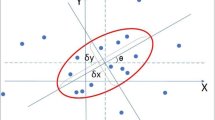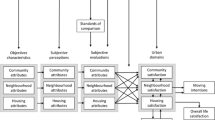Abstract
This paper studies the quality of life (QOL) that residents perceive in typical urban patterns in Ho Chi Minh City. Its major focus is to examine the improvement in the QOL through public intervention into the urban development process. There are four findings. First, moderate government intervention to correct market failures in areas where spontaneous urban development has occurred generates similar levels of satisfaction to areas with planned development. Second, urban planning is important as housing values and subjective satisfactions in planned areas are higher than those in spontaneous development areas. Third, redevelopment negatively affects the QOL in areas undergoing redevelopment. Finally, the contrast between the housing value and the subjective life satisfaction in spontaneous development areas undergoing redevelopment shows the problem of relying on the revealed preference assumption in traditional economics and the need for having alternative approaches.


Similar content being viewed by others
References
Alonso, W. (1964). Location and land use. Cambridge: Harvard University Press.
Arnott, R. (2009). Housing policies in developing countries: the importance of the informal economy. In M. Spence, P. C. Annez, R. M. Buckley (Eds.), Urbanization and Growth. World Bank Publications, pp. 167–196.
Belsky, E. S., et al. (2013). Advancing Inclusive and Sustainable Urban Development: Correcting Planning Failures and Connecting Communities to Capital, Joint Cener for Housing Studies of Harvard Univesity.
Bertaud, A. (2004). The spatial organization of cities: deliberate outcome or unforeseen. Institute of Urban and Regional Development.
Blanchflower, D. G., & Oswald, A. J. (2004). Money, sex and happiness: an empirical study. Scandinavian Journal of Economics, 106(3), 393–415. doi:10.1111/j.0347-0520.2004.00369.x [Accessed September 22, 2015].
Blomquist, G. C., Berger, M. C., & Hoehn, J. P. (1988). New estimates of quality of life in urban areas. American Economic Review, 78(1), 89–107.
Chen, Z., & Davey, G. (2009). Subjective quality of life in Zhuhai City, South China: a public survey using the international wellbeing index. Social Indicators Research, 91(2), 243–258.
Clark, A., & Oswald, A. (1994). Unhappiness and unemploy. Economic Journal, 104(242), 648–59.
Clawson, M. (1975). Economic and social conflicts in land use planning. Natural Resources Journal, 15.
ALMEC Corporation (2004). The study on urban transport master plan and feasibility study in Ho Chi Minh metropolitan area (HOUTRANS).
CPV (2002). Resolution 20-NQ/TW. Available at: In Vietnamese.
Craglia, M., et al. (2004). Towards the development of quality of life indicators in the “digital” city. Environment and Planning B: Planning and Design, 31(1), 51–64. Available at: http://epb.sagepub.com/content/31/1/51.abstract [Accessed September 22, 2015].
Dapice, D., Gomez-Ibanez, J., Nguyen, X. T. (2010). Ho Chi Minh City: the challenges of growth, Vietnam Program at Harvard Kennedy School of Government.
Diener, E. D., & Suh, E. (1997). Measuring quality of life: economic, social, and subjective indicators. Social Indicators Research, 40(1/2), 189–216.
Dolan, P., Peasgood, T., White, M. (2008). Do we really know what makes us happy? A review of the economic literature on the factors associated with subjective well-being. Journal of Economic Psychology, 29(1), 94–122. Available at: http://www.sciencedirect.com/science/article/pii/S0167487007000694 [Accessed July 14, 2014].
DOS-HCMC (2011). Statistical yearbook, 2010.
DOS-HCMC (2015). Statistics in 2014.
Easterlin, R. (1974). Does economic growth improve the human lot? Some empirical evidence. In P. A. David & M. W. Reder (Eds.), Nations and households in economic growth: essays in honor of Moses Abramowitz (pp. 89–124). New York: Academic.
ECA International (2012). Hong Kong: Asia’s Third Most Liveable City, but among the World’s Worst for Air Quality.
EIU (2012). Best cities ranking and report.
European Commission (2013). Quality of life in cities: perception survey in 79 European cities, Available at: http://ec.europa.eu/regional_policy/sources/docgener/studies/pdf/urban/survey2013_en.pdf.
Fainstein, S. (2001). The city builders: Property Development in New York and London.
Fainstein, S. (2010). The just city. Ithaca: Cornell University Press.
Fainstein, N., Fainstein, S. S. (2010). The changing character of urban redevelopment since 1945 *.
Fayers, P. M., & Hand, D. J. (1997). Factor analysis, causal indicators and quality of life. Quality of Life Research : an International Journal of Quality of Life Aspects of Treatment, Care and Rehabilitation, 6(2), 139–150.
Felce, D., & Perry, J. (1995). Quality of life: its definition and measurement. Research in Developmental Disabilities, 16(1), 51–74. Available at: http://www.sciencedirect.com/science/article/pii/0891422294000288 [Accessed June 30, 2015].
Feler, L., & Henderson, J. V. (2011). Exclusionary policies in urban development: under-servicing migrant households in Brazilian cities. Journal of Urban Economics, 69(3), 253–272.
Gyourko, J. (1991). How accurate are quality-of-life rankings across cities? Business Review (Federal Reserve Bank of Philadelphia).
Gyourko, J., Kahn, M., Tracy, J. (1999). Applied Urban Economics, Elsevier. Available at: http://www.sciencedirect.com/science/article/pii/S1574008099800066 [Accessed September 22, 2015].
Hill, R. (2011). Hedonic Price Indexes for Housing, OECD Statistics Directorate.
Huynh, T. D. (2012). The transformation of Ho Chi Minh City: issues in managing growth. Harvard.
Huynh, T. D. (2015). The misuse of urban planning in Ho Chi Minh City. Habitat International, 48, 11–19.
Kim, B.-K. (1998). Socioeconomic status and perception of the quality of life in Korea. Development and Society, 27(2), 15.
Lambiri, D., Biagi, B., & Royuela, V. (2006). Quality of life in the economic and urban economic literature. Social Indicators Research, 84(1), 1–25. doi:10.1007/s11205-006-9071-5 [Accessed September 17, 2015].
Lelkes, O. (2006). Knowing what is good for you. The Journal of Socio-Economics, 35(2), 285–307.
Lora, E., et al. (2010). The Quality of Life in Latin American Cities. In E. Lora, et al. (eds.), New York: The Inter-American Development Bank and The World Bank.
Malpezzi, S. (2002). Housing economics: essays in honor of Duncan Maclennan. In K. Gibb, A. O’Sullivan (eds), Land Economics, 67–89.
Mercer Consultant Company (2012). Livable ranking - Mercer’s 205 cities in 2012.
Mills, E. S. (1967). An aggregative model of resource allocation in a metropolitan area. American Economic Review, 57(2), 197–210.
Morais, P., Miguéis, V. L., Camanho, A. S. (2011). Quality of life experienced by human capital: an assessment of European cities. Social Indicators Research.
Muth, R. F. (1969). Cities and Housing, University of Chicago Press.
Nguyen, M. H. (2008). Potential for Saigon river miracle. Vietnamese: Ho Chi Minh City General Publisher.
Nguyen, D. D. (2012). Saigon South: a brief history of planning. http://dothivietnam.org/. Available at: http://dothivietnam.org/2012/03/12/namsg/.
Ni, P., Oyeyinka, B., Chen, F. (2015). Urban Innovation and Upgrading in China Shanty Towns - Changing, Available at: http://www.springer.com/us/book/9783662439043 [Accessed September 17, 2015].
Peiser, R. B. (1984). Does it pay to plan suburban growth? Journal of the American Planning Association, 50(4), 419–433.
Pichler, F. (2006). Subjective quality of life of young Europeans. Feeling happy but who knows why? Social Indicators Research, 75(3), 419–444. doi:10.1007/s11205-004-4337-2 [Accessed September 22, 2015].
Powell, A., & Sanguinetti, P. (2010) Measuring quality of life in Latin America’s urban neighborhoods: a summary of results from the city case studies. In E. Lora et al. (eds.), The Quality of Life in Latin American Cities. International American Development Bank and World Bank, p. 296.
van Praag, B. M. S., & Ferrer-i-Carbonell, A. (2010). Toward an urban quality of life index: basic theory and econometric methods. In E. Lora et al. (eds.), The Quality of Life in Latin American Cities. International American Development Bank and World Bank, p. 296.
Proctor, C. L., Linley, A., & Maltby, J. (2008). Youth life satisfaction: a review of the literature. Journal of Happiness Studies, 10(5), 583–630.
Reisig, M. D., & Parks, R. B. (2000). Experience, quality of life, and neighborhood context: a hierarchical analysis of satisfaction with police. Justice Quarterly, 17(3), 607–630.
Roback, J. (1982). Wages, rents, and the quality of life. Journal of Political Economy, 90(6), 1257–78.
Rodgers, D., Beall, J., & Kanbur, R. (2011). Latin American urban development into the twenty-first century: towards a renewed perspective on the city. European Journal of Development Research, 23(4), 550–568.
Rosen, S. (1979). Wage-based indexes of urban quality of life. In P. Mieszkowski & M. Straszheim (Eds.), Current issues in urban economics (pp. 74–104). Baltimore: Johns Hopkins Press.
Sheppard, S. (1999). Hedonic analysis of housing markets. In P. Cheshire & E. Mills (Eds.), Handbook of regional and urban economics (pp. 1595–1635). Amsterdam: North-Holland.
Sorensen, A.D., & Day, R.A. (1981). Libertarian planning. Town Planning Review, 52(4).
Stutzer, A., & Frey, B. S. (2008). Stress that doesn’t pay: the commuting paradox*. Scandinavian Journal of Economics, 110(2), 339–366. doi:10.1111/j.1467-9442.2008.00542.x [Accessed August 10, 2015].
Taylor, N. (1998). Urban planning theory since 1945. London: Sage Publications.
Thrift, N., & Forbes, D. (1986). The price of war: urbanization in Vietnam 1954-1985, Allen and Unwin Press.
Ton, N. Q. T., & Nguyen, T. H. (2007). The culture of Saigon alley society. Vietnamese: Ho Chi Minh City General Publisher.
Trinh, D. L., & Nguyen, Q. V. (1998). Socieconomic impacts of renovation on urban housing. Vietnamese: Social Science Publisher.
UN-Habitat (2003). The Challenge of Slums: Global Report on Human Settlements 2003.
UN-Habitat (2009). Planning Sustainable Cities: Global Report on Human Settlements 2009.
University of Texas (2014). Measures of appropriateness of factor analysis. Available at: http://www.utexas.edu/courses/schwab/sw388r7/Tutorials/PrincipalComponentsAnalysisintheLiterature_doc_html/027_Measures_of_Appropriateness_of_Factor_Analysis.html.
USAID (1972). Dialectics of Urban Proposal for the Saigon Metropolitan Area, Available at: http://pdf.usaid.gov/pdf_docs/PNAAK857.pdf.
Van Kamp, I., et al. (2003). Urban environmental quality and human well-being towards a conceptual framework and demarcation of concepts; a literature study. In Landscape and Urban Planning. pp. 5–18.
Waibel, M., et al. (2007). Housing for low-income groups in Ho Chi Minh City between reintegration and fragmentation approaches to adequate urban typologies and spatial strategies. The German Journal on Contemporary Asia, 103, 61–78.
World Bank (2009). World Development Report.
Acknowledgments
We are grateful to Pham Minh Thien Phuoc and her team for helping us to conduct the onsite survey. We thank our colleagues and friends for their help and support.
Author information
Authors and Affiliations
Corresponding author
Appendix
Appendix
ᅟ
Rights and permissions
About this article
Cite this article
Huynh, D.T., Peiser, R.B. From Spontaneous to Planned Urban Development and Quality of Life: the Case of Ho Chi Minh City. Applied Research Quality Life 11, 1357–1377 (2016). https://doi.org/10.1007/s11482-015-9442-7
Received:
Accepted:
Published:
Issue Date:
DOI: https://doi.org/10.1007/s11482-015-9442-7




